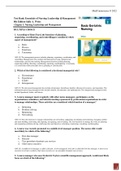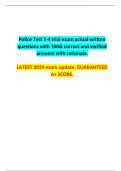MedConnoisseur © 2022
Test Bank Essentials of Nursing Leadership &Management
8th Edition Sally A. Weiss
Chapter 1: Nursing Leadership and Management
MULTIPLE CHOICE
1. According to Henri Fayol, the functions of planning,
organizing, coordinating, and controllingare considered which
aspect of management?
a. Roles
b. Process
c. Functions
d. Taxonomy
ANS: B, The management process includes planning, organizing, coordinating, and
controlling. Management roles include information processing, interpersonal
relationships, and decision making. Management functions include planning,
organizing,staffing, directing, coordinating, reporting, and budgeting. A taxonomy
is a system that orders principles into a grouping or classification.
2. Which of the following is considered a decisional managerial role?
a. Disseminator
b. Figurehead
c. Leader
d. Entrepreneur
ANS: D, The decisional managerial roles include entrepreneur, disturbance handler, allocator of resources, and negotiator. The
information processing managerial roles include monitor, disseminator, and spokesperson. The interpersonal managerial roles
include figurehead, leader, and liaison.
3. A nurse manager meets regularly with other nurse managers, participates on the
organizations committees, and attends meetings sponsored by professional organizations in order
to manage relationships. These activities are considered which function of a manager?
a. Informing
b. Problem solving
c. Monitoring
d. Networking
ANS: D, The role functions to manage relationships are networking, supporting, developing and mentoring, managing conflict
and team building, motivating and inspiring, recognizing, and rewarding. The role functions to manage the work are planning
and organizing, problem solving, clarifying roles and objectives, informing, monitoring, consulting, and delegating.
4. A nurse was recently promoted to a middle-level manager position. The nurses title would
most likely be which of the following?
a. First-line manager
b. Director
c. Vice president of patient care services
d. Chief nurse executive
ANS: B, A middle-level manager is called a director. A low managerial- level job is called the first-line manager. A nurse in an
executive level role is called a chief nurse executive or vice president of patient care services.
5. A nurse manager who uses Frederick Taylors scientific management approach, would most likely
focus on which of the following?
1
, MedConnoisseur © 2022
a. General principles
b. Positional authority
c. Labor productivity
d. Impersonal relations
ANS: C, The area of focus for scientific management is labor productivity. In bureaucratic theory, efficiency is achieved through
impersonal relations within a formal structure and is based on positional authority. Administrative principle theory consists of
principles of management that are relevant to any organization.
6. According to Vrooms Theory of Motivation, force:
a. is the perceived possibility that the goal will be achieved.
b. describes the amount of effort one will exert to reach ones goal.
c. describes people who have free will but choose to comply with orders they are given.
d. is a naturally forming social group that can become a contributor to an organization.
ANS: B, According to Vrooms Theory of Motivation, Force describes the amount of effort one will exert to reach ones goal.
Valence speaks to the level of attractiveness or unattractiveness of the goal. Expectancy is the perceived possibility that the goal
will be achieved. Vrooms Theory of Motivation can be demonstrated in the form of an equation: Force = Valence Expectancy
(Vroom, 1964). The theory proposes that this equation can help to predict the motivation, or force, of an individual as described
by Vroom.
7. According to R. N. Lussier, motivation:
a. is unconsciously demonstrated by people.
b. occurs externally to influence behavior.
c. is determined by others choices.
d. occurs internally to influence behavior.
ANS: D, Motivation is a process that occurs internally to influence and direct our behavior in order to satisfy needs. Motivation
is not explicitly demonstrated by people, but rather it is interpreted from their behavior. Motivation is whatever influences our
choices and creates direction, intensity, and persistence in our behavior.
8. According to R. N. Lussier, there are content motivation theories and process motivation
theories. Which of the following is considered a process motivation theory?
a. Equity theory
b. Hierarchy of needs theory
c. Existence-relatedness-growth theory
d. Hygiene maintenance and motivation factors
ANS: A, The process motivation theories are equity theory and expectancy theory. The content motivation theories include
Maslows hierarchy of needs theory, Aldefers existence- relatedness-growth (ERG) theory, and Herzbergs hygiene maintenance
factors and motivation factors.
9. The theory that includes maintenance and motivation factors is:
a. Maslows hierarchy of needs.
b. Herzbergs two-factor theory.
c. McGregors theory X and theory Y.
d. Ouchis theory Z.
ANS: B, The two-factor theory of motivation includes motivation and maintenance factors. Maslows hierarchy of needs includes
the following needs: physiological, safety, security, belonging, and self-actualization. In theory X, employees prefer security,
direction, and minimal responsibility. In theory Y, employees enjoy their work, show self-control and discipline, are able to
2
, MedConnoisseur © 2022
contribute creatively, and are motivated by ties to the group, organization, and the work itself. The focus of theory Z is collective
decision making and long-term employment that involves slower promotions and less direct supervision.
10. A nurse is appointed to a leadership position in the local hospital. The nurses position would be
considered which of the following?
a. Informal leadership
b. Formal leadership
c. Leadership
d. Management
ANS: B, Formal leadership is based on occupying a position in an organization. Informal leadership is shown by an individual
who demonstrates leadership outside the scope of a formal leadership role or as a member of a group. Leadership is a process of
influence whereby the leader influences others toward goal achievement. Management is a process to achieve organizational
goals.
11. A nursing instructor is evaluating whether the nursing students understand the three
fundamental qualities that leaders share. According to Bennis and Nanus, the fundamental
qualities of effective leaders are:
a. guided vision, passion, and integrity.
b. knowledge of self, honesty, and maturity.
c. intelligence, self-confidence, and determination.
d. honesty, self-awareness, and sociability.
ANS: ABennis and Nanus list guided vision, passion, and integrity as fundamental qualities of effective leaders. Knowledge of
self, honesty and maturity; intelligence, self-confidence and determination; self-awareness and sociability are all desirable
traits in leaders as well as in others.
12. The six traits identified by Kirkpatrick and Locke that separate leaders from non-leaders were:
a. respectability, trustworthiness, flexibility, self-confidence, intelligence, sociability.
b. self-confidence, progression of experiences, influence of others, personal life factors, honesty,
drive.
c. intelligence, self-confidence, determination, integrity, sociability, honesty.
d. drive, desire to lead, honesty, self-confidence, cognitive ability, knowledge of business.
ANS: D, Research by Kirkpatrick and Locke concluded that leaders possess six traits: drive, desire to lead, honesty, self-
confidence, cognitive ability, and knowledge of the business. Woods identified five dominant factors that influenced leadership
development: self-confidence, innate qualities, progression of experience, influence of significant others, and personal life
factors. Stogdill identified the following traits of a leader: intelligence, self- confidence, determination, integrity, and
sociability. Murphy and DeBack identified the following leader characteristics: caring, respectability, trustworthiness, and
flexibility.
13. A nurse manager who uses a leadership style that is participatory and where authority
is delegated to others is most likely using which of the following leadership styles?
a. Autocratic
b. Democratic
c. Laissez-faire
d. Employee-centered
ANS: B, Democratic leadership is participatory, and authority is delegated to others. Autocratic leadership involves centralized
decision making, with the leader making decisions and using power to command and control others. Laissez-faire leadership is
passive and permissive, and the leader defers decision making. Employee-centered leadership focuses on the human needs of
subordinates.
3
, MedConnoisseur © 2022
14. A characteristic of the consideration dimension of leadership behavior is:
a. focus on the work to be done
b. focus on the task.
c. focus on production.
d. focus on the employee.
ANS: D, The leadership dimension of consideration involves activities that focus on the employee. Initiating structures of
leadership involves an emphasis on the work to be done, and a focus on the task and production.
15. The leadership theory that considers follower readiness as a factor in determining
leadership style is:
a. contingency.
b. path goal.
a. situational.
c. charismatic.
ANS: C, Situational leadership considers the follower readiness as a factor in determining leadership style. Contingency theory
views the pattern of leader behavior as dependent on the interaction of the personality of the leader and the needs of the situation.
In path goal theory, the leader works to motivate followers and influence goal accomplishment. Charismatic leadership has an
inspirational quality that promotes an emotional connection from followers.
16. In contingency theory, the feelings and attitudes of followers regarding acceptance, trust, and
credibility of the leader are called:
a. task structure.
b. position power.
c. low task structure.
d. leader-member relations.
ANS: D, In contingency theory, leader-member relations are the feelings and attitudes of followers regarding acceptance, trust,
and credibility of the leader. Task structure of contingency theory means the degree that work is defined, with specific
procedures, explicit directions, and goals. Low task structure involves work that is not routine, predictable, or clearly defined.
Position power in contingency theory is the degree of formal authority and influence associated with the leader. REF:
FIEDLERS CONTINGENCY THEORY
17. In situational theory, a telling leadership style is considered:
a. high task, high relationship behavior.
b. high task, low relationship behavior.
c. low task, high relationship behavior.
d. low task, low relationship behavior.
ANS: B, A telling leadership style is high task behavior and low relationship behavior. A high task, high
relationship style is called a selling leadership style. A low task and high relationship style is called a
participating leadership style. A low task and low relationship style is called a delegating leadership style.
REF: HERSEY AND BLANCHARDS SITUATIONAL THEORY
18. A nursing group has been very successful in achieving its goals even though the group has
lacked leadership. Which of the following factors is probably most responsible for the groups
success in goal achievement?
a. Life experience
b. Extrinsic satisfaction
c. Informal organizational structures
4






